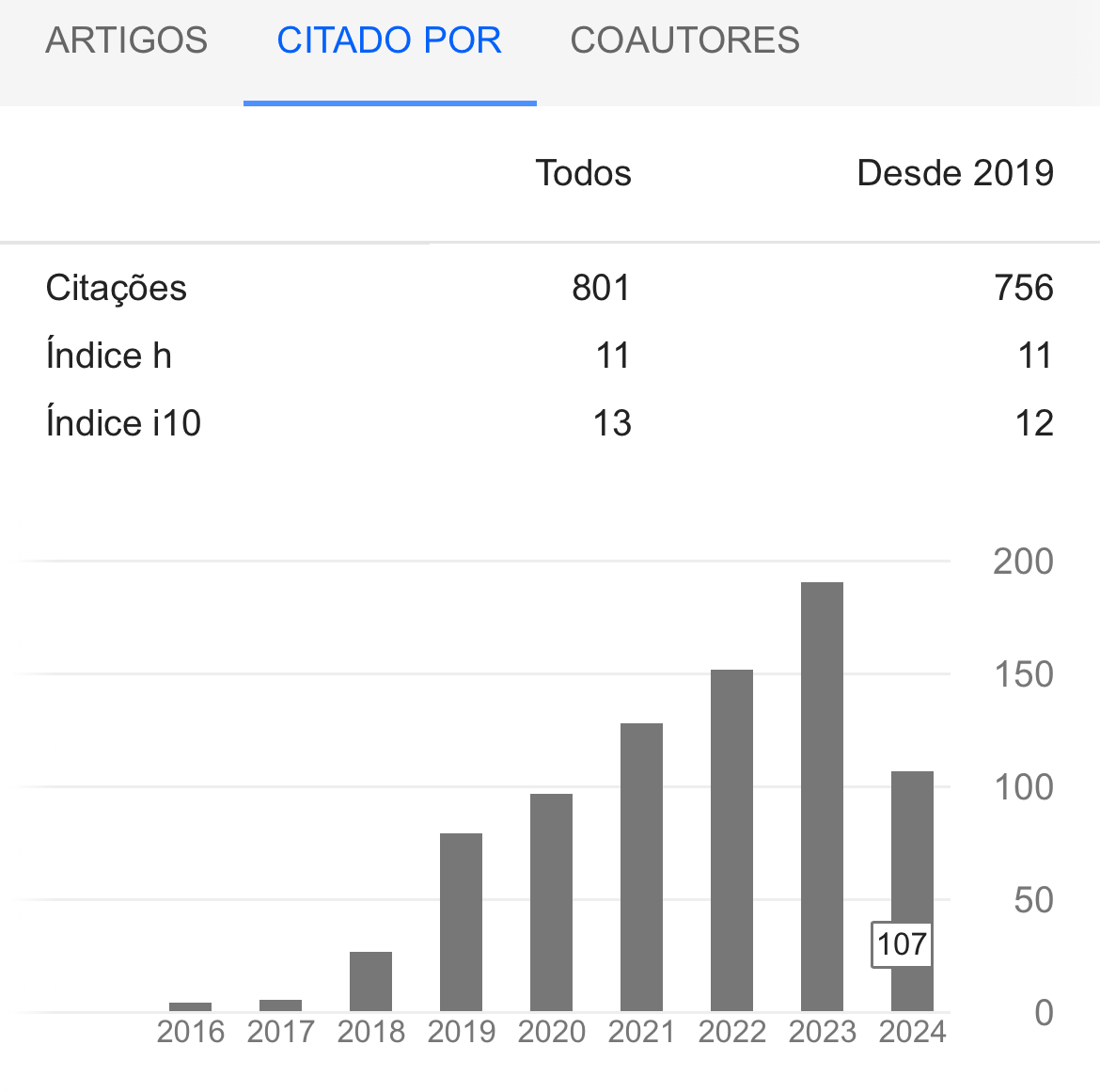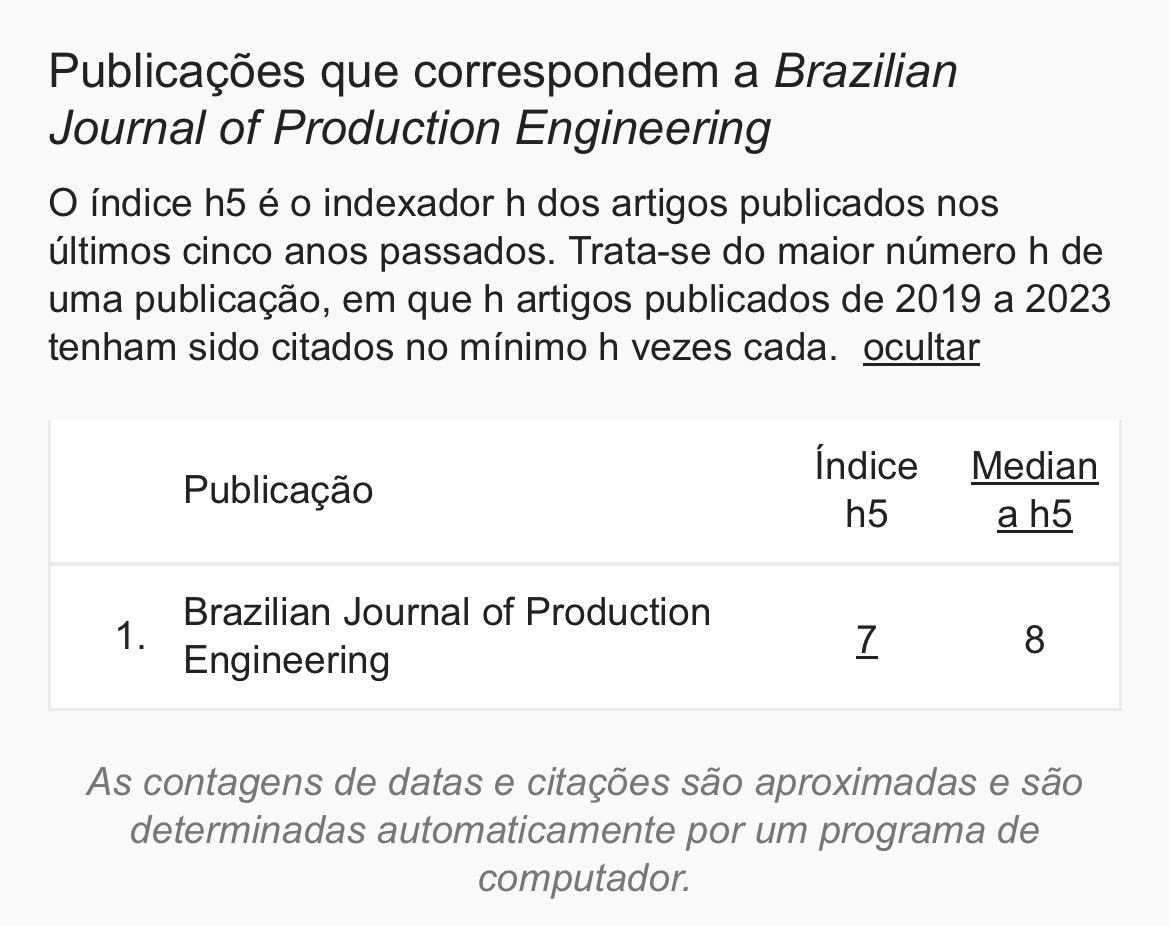Bibliometric analysis of alternatives for removing nutrients from wastewater in Scopus, Web Of Science and Scielo databases
DOI:
https://doi.org/10.47456/bjpe.v6i7.32903Keywords:
Eutrophication; Treatement; effluent;Abstract
The exponential growth of the population and the excessive use of water resources have been generating environmental problems, such as the contamination of rivers, seas and soil, as well as for people with regard to water scarcity. Therefore, the present work is justified by the importance of generating information about the actions that can be taken to reuse contaminated water. Thus, the objective is to carry out a bibliometric analysis on what are the main alternatives for removing nutrients from water bodies using the Scopus, Web of Science and SciELO bases. For this, a literature review was carried out for theoretical foundation and identification of the databases, definition of keywords that would be used in the databases and application of filters to select the articles that matched the theme and consequently form the portfolio relevant work. From this, 9 articles were obtained in the Scopus database, 5 in WoS and 3 in SciELO to compose the portfolio. Based on the bibliometric analysis carried out on the Scopus, Web of Science and SciELO databases, it was possible to visualize the growth of research aimed at solving environmental problems caused by the release of nutrients into the environment.
Downloads
References
Barbetta, P. A. (2007). Estatística Aplicada Às Ciências Sociais. Florianópolis: Editora UFSC.
Boyle, F., & Sherman, D. (2006). The product and its development. The Serials Librarian, Philadelphia, 49(3), 147-153.
Brasil. Ministério do Meio Ambiente. (2011). Conselho Nacional do Meio Ambiente - Conama. Resolução Nº 430 de 13/05/2011 (Federal) - Dispõe sobre as condições e padrões de lança mento de efluentes complementam e alteram a Resolução Nº 357, de 17 de março de 2005, do Conselho Nacional do Meio Ambiente - CONAMA. 2011. Acesso em: 06 ago. 2020. Disponível em: <http://bit.ly/1FY24dj>.
Brasil. (2010). Política Nacional de Resíduos Sólidos. Lei Nº 12.305, de 2 de agosto de 2010. Presidência da República, Departamento da Casa Civil. Brasília. Acesso em: 20 abr. 2020. Disponível em: < http://www.planalto.gov.br/ccivil_03/leis/L9605.htm>.
Brasil. (1998). Lei nº 9.605, de 12 de fevereiro de 1998. Dispõe sobre as sanções penais e administrativas derivadas de condutas e atividades lesivas ao meio ambiente, e dá outras providências. Diário Oficial da União, Brasília, 13 fev. 1998. Acesso em: 20 abr. 2020. Disponível em: < http://www.planalto.gov.br/ccivil_03/leis/L9605.htm>.
Cay, T., & Uyan, M. (2013). Evaluation of reallocation criteria in land consolidation studies using the Analytic Hierarchy Process (AHP). Land Use Policy, Mersin, 30(1), 541- 548.
Cole, A. J., Neveux, N., Whelan, A., Morton, J., Vis, M., De Nys, R., & Paul, N. A. (2016). Adding value to the treatment of municipal wastewater through the intensive production of freshwater macroalgae. Algal Research-Biomass Biofuels And Bioproducts. 20(1), 100-109.
Cui, W., Wu, Y., Liu, S., Wei, F., Zhou, M. X., & Qu, H. (2010). Context preserving dynamic word cloud visualization. Pacific Visualization Symposium. Taipei, 1(1), 121-128, doi: 10.1109/PACIFICVIS.2010.5429600.
Dupont, W. D. ,& Plummer, W. D. (1990). Power and sample size calculations: a review and computer program. Controlled clinical trials, Nashville, 11(2), 116-128.
Elsevier. (2020). Guia de referência rápida. Acesso em: 10 ago. 2020. Diponivel em: https://www.periodicos.capes.gov.br/images/documents/Scopus_Guia%20de%20refer%C3% AAncia%20r%C3%A1pida_10.08.2016.pdf.
Filippino, K. C., & Mulholland, M. R. (2015). Bott, C. B. Phycoremediation strategies for rapid tertiary nutrient removal in a waste stream. Algal Research-Biomass Biofuels And Bioproducts. 11(1), 125-133.
Franco D., Lee J., Arbelaez S., & Cohen N. (2017). Kim J.Y. Removal of phosphate from surface and wastewater via electrocoagulation. Ecological Engineering. 108(1), 589-596. https://doi.org/10.1016/j.ecoleng.2017.07.031.
Gabrielli, G., Paixao, J. L. da, Tonetti, L., & Coraucci, B. (2015). Ambiance rose production and nutrient supply in soil irrigated with treated sewage. Rev. bras. eng. agríc. ambient., Campina Grande , 19(8), 755-759. https://doi.org/10.1590/1807-1929/agriambi.v19n8p755-759.
Garcia, F. C. (2016). Identidade e imagem da marca: Uma análise comparativa em uma empresa do setor de serviços de telecomunicações. Dissertação (Mestrado em Administração. Universidade Federal de Uberlândia, Uberlândia.
Guedón, J. C. (2010). Acesso aberto e divisão entre ciência predominante e ciência periférica. Acessibilidade e visibilidade de revistas cientificas eletrônicas. São Paulo: SENAC São Paulo. Cengage Learning, 21-77.
Hao, H., Wang, Y., & Shi, B. (2019). NaLa(CO3)2 hybridized with Fe3O4 for efficient phosphate removal: Synthesis and adsorption mechanistic study. Water Research. 155(1), 01-11, 2019. https://doi.org/10.1016/j.watres.2019.01.049.
Joao, J. J., Locks, L., Vieira, J. L., & Lucia, E. A. (2020). Rice husks as a microbial source for wastewater treatment. Rev. bras. eng. agríc. ambient., Campina Grande , 24(5), 343-347. https://doi.org/10.1590/1807-1929/agriambi.v24n5p343-347.
Karunanithi, R., Szogi, A.A., Bolan, N. N. R., Loganathan, P., Hunt, P.G., Vanotti, M. S., Ok, Y. S., & Krishnamoorthy, S. (2015). Phosphorus Recovery and Reuse from Waste Streams. Advances in Agronomy. 131(1), 173-250. 10.1016/bs.agron.2014.12.005.
Lacerda, R. T. de O, Ensslin, L., & Ensslin, S. R. (2012). Uma análise bibliométrica da literatura sobre estratégia e avaliação de desempenho. Gestão & Produção, São Carlos, 19(1).
Lam A., Kurisu K., & Hanaki, K. (2015). Comparative environmental impacts of source-separation systems for domestic wastewater management in rural China. Journal of Cleaner Production. 104(1), 185-198. https://doi.org/10.1016/j.jclepro.2015.04.126.
Li, R., Morrison, L., Collins, G., Li, A., & Zhan, X. (2016). Simultaneous nitrate and phosphate removal from wastewater lacking organic matter through microbial oxidation of pyrrhotite coupled to nitrate reduction. Water Research. 96(1), 32-41.
Marchello, A. E., Lombardi, A. T., Dellamano-Oliveira, M. J., & Souza, C. W.O. de. (2015). Microalgae population dynamics in photobioreactors with secondary sewage effluent as culture medium. Braz. J. Microbiol., São Paulo, 46(1), 75-84. Acesso em: 21 Set. 2020. Disponível em: <http://www.SciELO.br/SciELO.php?script= sci_arttext&pid=S1517-83822015000100075&lng=en&nrm=iso>.
Mekonnen, M. M., & Hoekstra, A. Y. (2018). Cargas globais de fósforo antropogênico para a água doce e pegadas hídricas cinza associadas e níveis de poluição da água: um estudo global de alta resolução. Recursos Hídricos Research, 54(1), 345–358. https://doi.org/10.1002/2017WR020448
Meneghini, R. (2003). O projeto SciELO (Scientific Electronic Library on Line) e a visibilidade da literatura científica "Periférica". Quím. Nova, São Paulo, 26(2), 155-156. https://doi.org/10.1590/S0100-40422003000200001.
Moreira, J. R., Vilan Filho, J. L., & Mueller, S. P. M. (2015). Características e produção científica dos Grupos de pesquisa do CNPq/DGP nas áreas de Ciência da Informação e Museologia (1992 - 2012). Perspect. ciênc. inf., Belo Horizonte, 20(4), 93-106. Acesso em: 24 Ago. 2020. Disponível em: <http://www.SciELO.br/SciELO.php?script=sci_arttext&pid=S1413-99362015000400093&lng= en&nrm=iso>.
Mugnaini, R. (2006). Caminhos para adequação da avaliação da produção científica brasileira: impacto nacional versus internacional. São Paulo, 253 p. Tese (Doutorado em Ciência da Informação) - Escola de Comunicações e Artes. Universidade de São Paulo. Disponível em: <http://poseca.incubadora.fapesp.br/portal/bdtd/2006/2006-do-mugnaini_rogerio.pdf>. Acesso em: 18 jul. 2020.
Nasir, N., Bakar, N., Lananan, F., Abdul, H. S. H., Lam, S. S., & Jusoh, A. Treatment of African catfish, Clarias gariepinus wastewater utilizing phytoremediation of microalgae, Chlorella sp. with Aspergillus niger bio-harvesting. Bioresource technology. 190(1). Doi: 10.1016/j.biortech.2015.03.023.
Natura. Relatório Annual. (2018). Disponivel em: https://static.rede.natura.net/html/2019/a-natura/pdf/relatorio_anual_natura_2018.pdf. Acesso em: 06 out. 2020.
Pantano, G., Grosseli, G. M. Mozeto, A. A., & Fadini, P. S. (2016). Sustentabilidade no uso do fósforo: uma questão de segurança hídrica e alimentar. Quím. Nova, São Paulo, 39(6), 732-740. Doi; http://dx.doi.org/10.5935/0100-4042.20160086.
Praveen P., Heng J.Y.P., & Loh K. C. (2016). Tertiary wastewater treatment in membrane photobioreactor using microalgae: Comparison of forward osmosis & microfiltration. Bioresource Technology. 222(1), 448-457. Doi: https://doi.org/10.1016/j.biortech.2016.09.124.
São Paulo. CETESB -Águas interiores. (2020). Acesso em: 17 set. 2020. Disponível em: https://cetesb.sp.gov.br/aguas-interiores/informacoes-basicas/tpos-de-agua/o-problema-da-escasez-de-agua-no-mundo/.
São Paulo. CETESB -Poluição das águas subterrâneas. (2016). Acesso em: 17 set. 2020. Disponível em: https://cetesb.sp.gov.br/aguas-subterraneas/informacoes-basicas/poluicao-das-aguas-subterraneas/.
Souza, C. D. de. A organização do conhecimento: Estudo bibliométrico na base de dados ISI Web of Knowledge. Biblios: Journal of Librarianship and Information Science, [s l.], n. 51, p.20-32, 4 jul. 2013.
Strehl, L. (2005). O fator de impacto do ISI e a avaliação da produção científica: aspectos conceituais e metodológicos. Ciência da informação. Brasília. 34(1), 19-27.
Sukacova, K,, Trtilek, M, & Rataj, T. (2015). Phosphorus removal using a microalgal biofilm in a new biofilm photobioreactor for tertiary wastewater treatment. Water Research. 71(1), 55-63. Doi: https://doi.org/10.1016/j.watres.2014.12.049.
Trindade, P. B. C. B., & Mendonca, A. S. F. (2014). Eutrofização em reservatórios – Estudo de caso: reservatório de Rio Bonito (ES). Eng. Sanit. Ambient., Rio de Janeiro , 19(3), 75-282.Doi: http://dx.doi.org/10.1590/S1413-41522014019000000537.
Wang, S.; LIN, X.; Yu, H.; Wang, Z.; Xia, H.; An, J. & Fan, G. (2017). Nitrogen removal from urban stormwater runoff by stepped bioretention systems. Ecological Engineering. 106(1), 340-348.
Wu, B., Fang, L., Fortner, J. D., Guan, X., & Lo, I. M. C. (2017). Highly efficient and selective phosphate removal from wastewater by magnetically recoverable La(OH)3/Fe3O4 nanocomposites, Water Research, 126(1), 179-188. https://doi.org/10.1016/j.watres.2017.09.034.
Wu, Y., Li, X., Yang, Q., Wang, D., Xu, Q., Yao, F., Chen, F., Tao, Z., & Huang, X. (2019). Hydrated lanthanum oxide-modified diatomite as highly efficient adsorbent for low-concentration phosphate removal from secondary effluents. Journal of Environmental Management. 231(1), 370-379. https://doi.org/10.1016/j.jenvman.2018.10.059.
Xie, J., Lai, L., Lin, L., Wu, D., Zhang, Z., & Kong, H. (2015). Phosphate removal from water by a novel zeolite/lanthanum hydroxide hybrid material prepared from coal fly ash. Journal of Environmental Science and Health. 50(12), 1298-1305. DOI: 10.1080/ 10934529.2015.1055159.
Downloads
Published
How to Cite
Issue
Section
License
Copyright (c) 2020 Brazilian Journal of Production Engineering - BJPE

This work is licensed under a Creative Commons Attribution-NonCommercial-ShareAlike 4.0 International License.











































































